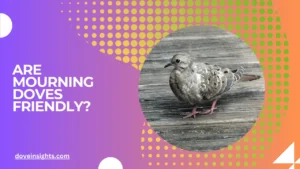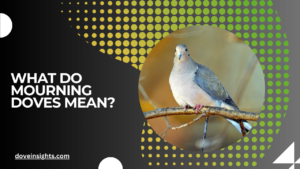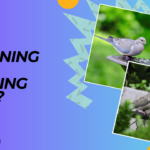Have you ever observed a mourning dove closely and wondered why, despite their elegance, their feathers sometimes seem a bit worn or uneven?
It’s easy to overlook, but this apparent shift in their appearance is part of a natural process that many birds experience—molting. You may not realize it, but every year, mourning doves go through a fascinating transformation that ensures their feathers remain in top condition for survival.
In this article, we’ll delve into the world of mourning dove molt, exploring the why, when, and how of this essential process.
Molting is critical for maintaining a bird’s aerodynamics, insulation, and overall health. Understanding this process not only helps us appreciate these graceful creatures more but also sheds light on their behavior and seasonal changes.
Let’s explore why molting is so important for mourning doves and how it impacts their daily life.
Contents
What is Molt and Why Is It Important for Mourning Doves?
Molt refers to the process by which birds shed their old feathers and grow new ones. This natural process is essential for maintaining feather quality, which in turn ensures the bird’s ability to fly, stay warm, and stay healthy.
For mourning doves, molt is crucial because their feathers experience wear and tear throughout the year. Whether they are navigating harsh winds, taking flight in search of food, or engaging in territorial disputes, their feathers can become damaged and less effective over time.
Feathers are more than just a physical feature for mourning doves; they are vital for aerodynamics, insulation, and protection.
Healthy feathers allow mourning doves to fly efficiently and help them maintain the necessary body temperature in fluctuating climates. The molt process, which happens in specific stages, allows them to replace old feathers with fresh ones, ensuring they can continue to thrive in their environment.
The Timing of Mourning Dove Molt
Mourning doves undergo molt at different times of the year depending on the climate and their location. Generally, mourning doves begin their molt after the breeding season, typically in the late summer or early fall.
This timing ensures that their feathers are refreshed before the harsh winter months.
Molting happens gradually and does not occur all at once. Mourning doves replace feathers in a sequential pattern, often starting with the primary flight feathers and gradually working their way to the tail feathers and body feathers.
This careful process ensures that the bird can still fly and function normally throughout the molt, without being grounded due to lack of feathers. The timing and duration of molt can also vary based on the bird’s health, environment, and weather conditions.
How Mourning Doves Molt: A Step-by-Step Process
The process of molt in mourning doves is not immediate. It’s a careful and intricate cycle, which typically lasts for about 2 to 3 months. Here’s a breakdown of how the molt process works:
- Initial Molt Phase: After the breeding season, mourning doves begin replacing their primary flight feathers. These feathers are the most critical for flight, so they are replaced first to ensure the bird can continue flying during the molt.
- Tail Feathers Molt: The tail feathers, which are vital for stability and maneuvering, are replaced after the primary feathers. Mourning doves often lose a few tail feathers at a time, so they can still maintain balance during flight.
- Body Feathers Molt: Finally, the dove will molt its body feathers, which help with insulation and aerodynamics. The body feathers are generally replaced last, and this process can continue into the fall.
Throughout the molt, mourning doves usually become quieter, as they are focusing on survival and conserving energy for the molt. Their flight patterns may become less graceful at times, but once the molt is completed, their feathers are once again full and functional.
Environmental Factors That Influence Molt in Mourning Doves
Mourning doves are highly adaptable birds, but their molt can still be influenced by environmental factors. Temperature, food availability, and habitat conditions all play a role in the timing and quality of the molt.
For example, in warmer climates, mourning doves may experience a longer molt period because they have a more extended breeding season.
In contrast, doves in colder climates might molt faster to prepare for winter. The availability of nutrient-rich food during the molt phase is also critical. If food is scarce, mourning doves may not have the energy to complete the molt efficiently, resulting in incomplete feather replacement or weaker feathers.
Additionally, stress factors, such as predators or human disturbance, can delay or interfere with the molt process. If a dove feels threatened, it may prioritize survival over molting, potentially leading to a disruption in the natural cycle.
Signs of a Mourning Dove in Molt and How to Observe the Process

Observing a mourning dove during its molt can be an enlightening experience. There are a few signs that can indicate a mourning dove is undergoing this process:
- Feathers looking ragged or uneven: As mourning doves molt, their old feathers often appear ragged or broken. You might see bald patches or uneven feather patterns as they replace old feathers with new ones.
- Changes in behavior: Mourning doves may become less vocal and more reclusive during molt. They tend to conserve energy, which can lead to less activity around feeders and roosting sites.
- Fluctuations in flight patterns: Doves might not fly as gracefully during molt, as they are still replacing their primary flight feathers. You might notice them flying in a less steady manner or taking shorter flights.
By watching closely, you can track a mourning dove’s progress as it goes through the stages of molt, appreciating the beauty and complexity of this natural process.
Conclusion:
Molting is an essential part of the mourning dove’s life cycle, helping them maintain functional feathers and ensuring their ability to survive and thrive in their environments.
It’s a process that, while often unnoticed, is integral to their flight, protection, and overall health. Whether they are navigating harsh weather, migrating, or simply going about their daily routines, their feathers must be in top condition for them to succeed.
For nature enthusiasts, understanding the molt process is a window into the delicate balance of nature, showing how even the smallest changes in a bird’s physical appearance can have significant impacts on its behavior.
The next time you see a mourning dove, take a moment to appreciate the meticulous process of molt and the quiet beauty of these often-overlooked creatures.
FAQ’s
Do mourning doves molt every year?
Yes, mourning doves molt annually, typically after the breeding season, to replace old or damaged feathers.
How long does the molt process take in mourning doves?
Mourning doves generally undergo molt over a period of 2 to 3 months, with the process starting after the breeding season.
When do mourning doves molt?
Mourning doves typically begin their molt in the late summer or early fall after the breeding season ends.
What feathers are replaced first during molt?
Mourning doves replace their primary flight feathers first, followed by tail feathers and finally body feathers.
Can environmental conditions affect the molt process?
Yes, factors like temperature, food availability, and habitat conditions can influence the timing and success of the molt process.
Does molt affect a mourning dove’s behavior?
During molt, mourning doves may become less vocal, quieter, and more reclusive as they conserve energy for feather replacement.








